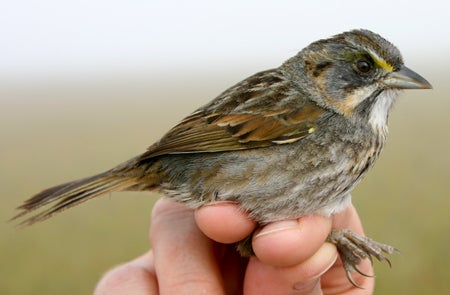SCIENTIFIC NAME:
Ammodramus maritimus () Wilson
OTHER NAMES:
Louisiana Seaside Sparrow (Norris 1968), Common Seaside-Sparrow (AOU 1998).
STATUS:
Breeder. Fairly common and local in all seasons in Gulf Coast region. HIGH CONSERVATION CONCERN.
DESCRIPTION:
Medium-sized (13-15 cm [5-6 in.]), dark, short-tailed sparrow. Resident subspecies of Alabama more variable in color than other races, but generally has a dominant back color of grayish olive rendered darker by dark brown streaks; underparts grayish white, with distinct buff or ochre breast band, striped brownish black on breasts, sides, and flanks. Has distinct yellow spot in front of eye, and blackish moustache stripe set off by white throat and buffy malar stripe. Some individuals slightly to distinctly paler. Song, not significantly different from most other subspecies, a short series of one or more buzzy notes punctuated with a few weak chips (Post and Greenlaw 1994). As many as nine subspecies described, including now-extinct dusky seaside sparrow, endangered Cape Sable seaside sparrow , and the subspecies resident in Alabama, the Louisiana seaside sparrow (A. m. fisheri) (Post and Greenlaw 1994).
DISTRIBUTION:
Seaside sparrows breed in Atlantic coastal marshes from New Hampshire to northeastern Florida, southwestern Florida, and along GulfCoast from northwestern Florida to southern Texas (Post and Greenlaw 1994). The Louisiana seaside sparrow breeds from MobileBay west to Texas. Winter and breeding distributions similar for all subspecies, except for those individuals that breed from New Hampshire to New Jersey and that migrate south to winter along the East Coast (Post and Greenlaw 1994). In Alabama, absent from much of seemingly suitable coastal marsh habitats during breeding season, but present at other times of year (Imhof 1976).
HABITAT:
Salt and brackish marsh savannas. Along GulfCoast, low marshes composed of cordgrass, rushes, and saltgrass, with a minimal intrusion of woody plants selected. Within this habitat, requires grassy stems strong and dense enough for nest support. In addition, open or sparsely vegetated muddy areas needed for foraging, but do not need to be contiguous with breeding territories. A mosaic of vegetation types and open areas are favored over large dense stands of cordgrass (Post and Greenlaw 1994).
FEEDING HABITS:
Forages primarily by walking on ground, or less frequently by hopping or climbing through vegetation. Uses relatively long, slender bill to probe in mud and glean vegetation for insects, spiders, decapods, amphipods, mollusks, marine worms, and seeds (Post and Greenlaw 1994).
LIFE HISTORY AND ECOLOGY:
Nonmigratory except for northeastern population (Post and Greenlaw 1994). In Southeast, males establish territories in March and April using song and visual displays. Has monogamous mating system, and pairs remain together throughout breeding season and possibly throughout year in nonmigratory populations. Nesting begins primarily in April and can extend to late June. Females construct an open cup nest of grasses at heights ranging from zero to four meters (zero to three feet) in a variety of substrates, including cordgrass, rushes, shrubs, and tidal debris. Spring tides can affect nest placement. Two to five bluish or grayish white eggs with dark blotches laid and incubated by female for 12 days. Only female broods, but both parents feed nestlings; usually leave the nest nine to 11 days after hatching. Fed by both parents approximately 20 days after fledging. In northern Florida, predation by rice rats and fish crows primary cause for nest failure. Renests after failures, and two broods sometimes raised (Post and Greenlaw 1994).
BASIS FOR STATUS CLASSIFICATION:
Vulnerability of species varies widely in different regions (Post and Greenlaw 1994). In Florida, the dusky seaside sparrow has become extinct and other subspecific populations are of serious conservation concern (Kale 1996). Destruction of coastal marshes due to dredging, draining, filling, ditching, pollution, spoil disposal, and development is greatest threat to survival. As marsh habitat disappears and populations become smaller and more fragmented, they become subject to stochastic extirpation as has happened twice in Florida (Post and Greenlaw 1994). Partners In Flight (PIF) considers the seaside sparrow in need of conservation attention. In Alabama, the assigned Priority designation is due to limited winter and breeding distributions, uncertain population trends, and importance of Alabamacoastal marshes to species survival and conservation (PIF 2002).
Author:
Richard L. West






